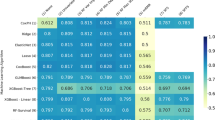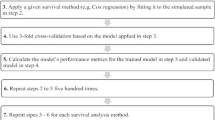Abstract
Machine learning models that aim to predict dementia onset usually follow the classification methodology ignoring the time until an event happens. This study presents an alternative, using survival analysis within the context of machine learning techniques. Two survival method extensions based on machine learning algorithms of Random Forest and Elastic Net are applied to train, optimise, and validate predictive models based on the English Longitudinal Study of Ageing – ELSA cohort. The two survival machine learning models are compared with the conventional statistical Cox proportional hazard model, proving their superior predictive capability and stability on the ELSA data, as demonstrated by computationally intensive procedures such as nested cross-validation and Monte Carlo validation. This study is the first to apply survival machine learning to the ELSA data, and demonstrates in this case the superiority of AI based predictive modelling approaches over the widely employed Cox statistical approach in survival analysis. Implications, methodological considerations, and future research directions are discussed.
H. Musto—Joint first-author.
Access this chapter
Tax calculation will be finalised at checkout
Purchases are for personal use only
Similar content being viewed by others
References
Hendrie, H.C.: Epidemiology of dementia and Alzheimer’s disease. Am. J. Geriatr. Psychiatry 6(2), S3–S18 (1998)
Ljubenkov, P.A., Geschwind, M.D.: Dementia. Semin. Neurol. 36, 4 (2016)
Dewey, M., Saz, P.: Dementia, cognitive impairment and mortality in persons aged 65 and over living in the community: a systematic review of the literature. Geriatr Psychiatry 16, 751–61 (2001)
Hill, G.B., Forbes, W.F., Lindsay, J.: Life expectancy and dementia in Canada: the Canadian study of health and aging. Chronic Dis. Can. 18, 166–167 (1997)
Brayne, G., Gao, L., Dewey, M., Matthews, F.E., Medical Research Council Cognitive Function and Ageing Study Investigators: Dementia before death in ageing societies— the promise of prevention and the reality. PLoS Med. 3(10), e397 (2006)
Deaths Registered in England and Wales (Series DR), 2013. Office for National Statistics (2014). http://www.ons.gov.uk/ons/dcp171778_381807.pdf
Kuehn, B.M.: Nearly half of dementia cases could be prevented or delayed. JAMA 324(11), 1025 (2020)
Goerdten, J., Cukic, I., Danso, S.O., et al.: Statistical methods for dementia risk prediction and recommendations for future work: a systematic review. Alzheimer’s Dementia Transl. Res. Clin. Interv. 5(1), 563–569 (2019)
Musto, H., Stamate, D., Pu, I., Stahl, D.: A machine learning approach for predicting deterioration in Alzheimer’s disease. In: 20th IEEE International Conference on Machine Learning and Applications (ICMLA), Pasadena (2021)
Lanham, J., et al.: Predicting risk of dementia with machine learning and survival models using routine primary care records. In: 2021 IEEE International Conference on Bioinformatics and Biomedicine (BIBM) (2021)
Mathotaarachchi, S., et al.: Identifying incipient dementia individuals using machine learning and amyloid imaging. Neurobiol. Aging 59, 80–90 (2017)
Moncada-Torres, A., van Maaren, M.C., Hendriks, M.P., Siesling, S., Geleijnse, G.: Explainable machine learning can outperform Cox regression predictions and provide insights in breast cancer survival. Sci. Rep. 11(1), 6968 (2021)
Omurlu, I.K., Ture, M., Tokatli, F.: The comparisons of random survival forests and Cox regression analysis with simulation and an application related to breast cancer. Expert Syst. Appl. 36(4), 8582–8588 (2009)
Kim, D.W., Lee, S., Nam, W., Kim, H.J.: Deep learning-based survival prediction of oral cancer patients. Sci. Rep. 9(1), 6994 (2019)
Spooner, A., et al.: A comparison of machine learning methods for survival analysis of high-dimensional clinical data for dementia prediction. Sci. Rep. 10(1) (2020)
Ajnakina, O., Cadar, D., Steptoe, A.: Interplay between socioeconomic markers and polygenic predisposition on timing of dementia diagnosis. J. Am. Geriatrics Soc. 16406 (2020)
Steptoe, A., Breeze, E., Banks, J., Nazroo, J.: Cohort profile: the English longitudinal study of ageing. Int. J. Epidemiol. 42, 6 (2013)
Deckers, K., et al.: Modifiable risk factors explain socioeconomic inequalities in dementia risk: evidence from a population-based prospective cohort study. J. Alzheimer’s Dis. 71(2), 549–557 (2019)
Hackett, R.A., Steptoe, A., Cadar, D., Fancourt, D.: Social engagement before and after dementia diagnosis in the English Longitudinal Study of Ageing. PLoS ONE 14, 8 (2019)
Rafnsson, S.B., Orrell, M., d’Orsi, E., Hogervorst, E., Steptoe, A.: Loneliness, social integration, and incident dementia over 6 years: prospective findings from the English longitudinal study of ageing. J. Gerontol. 75(1), 114–124 (2020)
Cadar, D., Lassale, C., Davis, H., Llewellyn, D.J., Batty, G.D., Steptoe, A.: Individual and area-based socioeconomic factors associated with dementia incidence in England: evidence from a 12-year follow-up in the English longitudinal study of ageing. JAMA Psychiat. 75(7), 723–732 (2018)
Jorm, A.F.: A short form of the Informant Questionnaire on Cognitive Decline in the Elderly (IQCODE): development and cross-validation. Psychol. Med. 24(1), 145–153 (1994)
Quinn, T.J., Fearon, P., et al.: Informant Questionnaire on Cognitive Decline in the Elderly (IQCODE) for the diagnosis of dementia within community dwelling populations. Cochrane Database Syst. Rev. (4), CD010079 (2014)
Steyerberg, E.W.: Clinical Prediction Models. A Practical Approach to Development, Validation, and Updating. SBH, Springer, Cham (2019)
Collins, G.S., Reitsma, J.B., Altman, D.G., Moons, K.G.: Transparent reporting of a multivariable prediction model for individual prognosis or diagnosis (TRIPOD): the TRIPOD statement. BMC Med. 122(2015), 434–443 (2015)
Harrell, F., Califf, R., Pryor, D., Lee, K., Rosati, R.: Evaluating the yield of medical tests. J. Am. Med. Assoc. 247, 2543–2546 (1982)
Clinical Practice Research Datalink | CPRD. https://cprd.com
Acknowledgments
Daniel Stamate is part-funded by Alzheimer’s Research UK (ARUK-PRRF2017-012), the University of Manchester, and Goldsmiths College, University of London. Daniel Stahl is part-funded by the National Institute for Health Research (NIHR) Maudsley Biomedical Research Centre at South London and Maudsley NHS Foundation Trust and King’s College London. The views expressed are those of the author(s) and not necessarily those of the NHS, the NIHR or the Department of Health and Social Care. Olesya Ajnakina is further funded by an NIHR Post-Doctoral Fellowship (PDF-2018-11-ST2-020).
Author information
Authors and Affiliations
Corresponding author
Editor information
Editors and Affiliations
Rights and permissions
Copyright information
© 2022 IFIP International Federation for Information Processing
About this paper
Cite this paper
Stamate, D., Musto, H., Ajnakina, O., Stahl, D. (2022). Predicting Risk of Dementia with Survival Machine Learning and Statistical Methods: Results on the English Longitudinal Study of Ageing Cohort. In: Maglogiannis, I., Iliadis, L., Macintyre, J., Cortez, P. (eds) Artificial Intelligence Applications and Innovations. AIAI 2022 IFIP WG 12.5 International Workshops. AIAI 2022. IFIP Advances in Information and Communication Technology, vol 652. Springer, Cham. https://doi.org/10.1007/978-3-031-08341-9_35
Download citation
DOI: https://doi.org/10.1007/978-3-031-08341-9_35
Published:
Publisher Name: Springer, Cham
Print ISBN: 978-3-031-08340-2
Online ISBN: 978-3-031-08341-9
eBook Packages: Computer ScienceComputer Science (R0)





